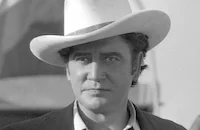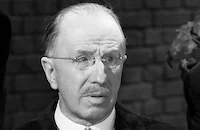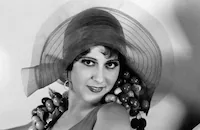Souls for Sale

Brief Synopsis
Cast & Crew
Rupert Hughes
Eleanor Boardman
Mae Busch
Barbara La Marr
Richard Dix
Frank Mayo
Film Details
Technical Specs

Synopsis
Remember Steddon, the daughter of a smalltown minister, marries Owen Scudder but has second thoughts while their train crosses the desert on their wedding night, and she leaves the train when it stops for water. A movie company on location finds her in poor condition and takes her to Hollywood. Because she has heard bad things about movie people, Mem at first rejects the urgings of director Frank Claymore and star Tom Holby to work in motion pictures, but she eventually makes the rounds of the studios (Famous Players--Lasky, Metro, Fox, Robertson-Cole, Pickford-Fairbanks, Goldwyn) in search of a job and sees many well-known directors and actors at work, including Stroheim ( Greed ), Fred Niblo ( The Famous Mrs. Fair ), and Charles Chaplin. Mem finally gets her chance from Frank Claymore, works hard, and steadily rises to fame. Claymore and Holby become friendly rivals for Mem's affections, while Scudder continues his habit of marrying unsuspecting girls, insuring them, and murdering them. Scudder comes to Hollywood to assert his marital claim on Mem, thus precipitating the climax in which there is an enormous fire, Scudder is killed by the wind machine he has aimed at Claymore, and Mem chooses Claymore over Tom Holby--to the delight of Robina Teele.

Director
Rupert Hughes
Cast

Eleanor Boardman

Mae Busch

Barbara La Marr

Richard Dix
Frank Mayo
Lew Cody

Arthur Hoyt
David Imboden
Roy Atwell
William Orlamond
Forrest Robinson

Edith Yorke
Dale Fuller
Snitz Edwards
Jack Richardson
Aileen Pringle
Eve Southern
May Milloy
Sylvia Ashton
Margaret Bourne
Fred Kelsey
Jed Prouty
Yale Boss

William Haines
George Morgan
Auld Thomas
Leo Willis
Walter Perry
Sam Damen
R. H. Johnson
Rush Hughes
L. J. O'connor
Charles Murphy
Hugo Ballin
Mabel Ballin
T. Roy Barnes
Barbara Bedford

Hobart Bosworth

Charles Chaplin

Chester Conklin
William H. Crane
Elliott Dexter

Robert Edeson

Claude Gillingwater
Dagmar Godowsky
Raymond Griffith
Elaine Hammerstein
Jean Haskell
K. C. B.
Alice Lake

Bessie Love
June Mathis

Patsy Ruth Miller
Marshall Neilan
Fred Niblo
Anna Q. Nilsson

Zasu Pitts
John Sainpolis
Milton Sills
Anita Stewart

Erich Von Stroheim

Blanche Sweet
Florence Vidor

King Vidor
Johnny Walker
George Walsh
Kathlyn Williams
Claire Windsor

Film Details
Technical Specs

Articles
Souls for Sale - Souls For Sale (1923)
Eleanor Boardman stars as Remember "Mem" Steddon, a small-town girl who has just married the amorous but mysterious Owen Scudder (Lew Cody). Suddenly and inexplicably terrified of her new husband, Mem jumps off their westbound train in the middle of a California desert. Wandering through the heat and dust, she is rescued by an Arabian prince on camelback -- having stumbled onto the location shoot of a Hollywood epic. Mem finds a home among show people, and is given a job as actress. But it isn't easy. One seasoned veteran (Arthur Hoyt) tells her, in classic showbiz-speak, "I'll make an actress of you if I have to break your heart and every bone in your body!" In one of the film's most effective scenes, Mem mugs shamelessly during a screen test, and then must painfully endure the results in the presence of studio executives. Instead of being played for laughs, it is a poignant (almost tragic) moment in which Mem is humbled, and realizes that screen acting is not as easy as it looks. In a hilarious twist on the overnight-star formula, Mem finally gets her big break when a huge spotlight crushes the legs of a film's leading lady... and must take her place in front of the cameras.
Mem's husband, we discover, is a modern Bluebeard, offing his well-insured wives as a means of avoiding honest work. When he discovers Mem's new career, he comes running to reclaim his bride (and the fortune attached to her). Fate intervenes, as it must. When Scudder invades the filming of Mem's new circus picture, lightning sets the big top ablaze, putting into motion a suitably melodramatic climax.
Souls for Sale relies upon its share of newly-minted Hollywood cliches, but it is a celebration of the myths and legends of Hollywood, not a realistic expose of the scandals and workings of the studio system. In fact it takes great care to avoid even the aroma of scandal. One intertitle offers a bit of Arbuckle-era moralizing, "When an actor gets into trouble, they blame the screen. A scandal is fatal to any one in the moving pictures." A scene depicting "one of the famous Thursday night hops at the Hollywood Hotel" seems to promise a bit of Prohibition-era decadence, but the title card dispels such expectations, "Many of the famous movie stars dance there until the heathenish hour of eleven thirty, unless they are too tired to keep awake so long."
Behind-the-scenes glimpses into the workings of the Hollywood studio system have always provided filmgoers with an added level of viewing pleasure. Like reading a fan magazine while sitting in the theatre, it allows them to enjoy the fictional pleasures of Hollywood make-believe, and at the same time experience insights into the normal lives of Tinseltown's elite.
But the reality offered by fan magazines in the 1920s was hardly the truth, and in the same way, behind-the-scenes dramas are little better than a different kind of make believe, in which big-screen stars merely pretend to be themselves -- a magic mirror revealing how Hollywood would like to see itself. And the viewer must constantly distinguish between the familiar Hollywood stars playing themselves, and those who are performing as fictional characters.
Such films are perhaps more valuable as documents of the science of silent filmmaking, for they reveal the usually invisible hardware of slates, cameras, lighting equipment, studio screening rooms and offices. One scene depicts a strange bit of cinema technology that is now extinct (and may have only been a figment of Hughes's imagination). When one of Steddon's films is playing in a theatre in Egypt, the intertitles are projected (in French and Arabic) on two screens adjacent to the main screen, resulting in a pre-Cinerama triptych that allows for optimum multi-lingual enjoyment.
As one would expect, Souls for Sale is peppered with star cameos, including Blanche Sweet, Patsy Ruth Miller, Raymond Griffith, Anna Q. Nilsson, and Chester Conklin. But it also features a surprising number of appearances by "star directors," such as King Vidor (The Big Parade [1925]), Fred Niblo (The Mark of Zorro [1920]), and Marshall Neilan (Daddy-Long-Legs [1919]). A plain-faced Charlie Chaplin pretends to direct Mem in another bit. The film also offers a particularly rare glimpse of screenwriter/editor June Mathis (The Four Horsemen of the Apocalypse [1921]).
Most fascinating of all the cameo bits is a scene showing Erich von Stroheim on the set of his legendary 1924 film Greed with an in-costume Jean Hersholt. Other members of Stroheim's stock company who appear in Souls for Sale (in and out of character) are Zasu Pitts, Dale Fuller and Mae Busch.
Rupert Hughes was the brother of oil-drilling magnate Howard Hughes Sr., and it was Rupert who introduced Howard Jr. to the pleasures of Hollywood, which no doubt contributed to his decision to spend his millions running various studios and production companies in the 1920s through the 1950s.
Rupert Hughes was recruited by Hollywood in 1919, when studio head Samuel Goldwyn launched a campaign to attract the literati to the screen. Other "Goldwyn Eminent Authors" included Mary Roberts Rinehart, Gertrude Atherton, and later, W.S. Maugham. Goldwyn wrote in his 1923 autobiography, "Mr. Hughes's success in photoplays can be ascribed to his prompt recognition of the gulf between two channels of expression -- literature and screen -- and to his determination to master both the technicalities and spirit of the latter."
Boardman began her career as a model, and was for years the official "Kodak girl" in the film company's print ads. She won her contract at the Goldwyn Studios as a result of the talent search "New Faces of 1921." Her co-winner was William Haines, who also appears in Souls for Sale as "Pinky." Starting salary at Goldwyn was $75 per week, and she was placed in the supporting cast pool. Hughes personally selected Boardman to be Mem Steddon in Souls for Sale, which was her first starring role.
In 1926, Boardman married director King Vidor (and starred in his 1928 film The Crowd), but their marital bliss was short-lived. They divorced in 1930 and struggled over custody and control of their two daughters for more than a decade. She died in 1991.
Director: Rupert Hughes
Producer: Rupert Hughes
Screenplay: Rupert Hughes, based on his novel
Cinematography: John J. Mescall
Music: Marcus Sjöwall
Cast: Eleanor Boardman (Remember Steddon), Lew Cody (Owen Scudder), Richard Dix (Frank Claymore), Mae Busch (Robina Teele), Frank Mayo (Tom Holby).
BW-80m.
by Bret Wood

Souls for Sale - Souls For Sale (1923)
Quotes
Trivia
Miscellaneous Notes
Released in United States 1923
Released in United States 1978
Released in United States 1923
Released in United States 1978 (Shown at FILMEX: Los Angeles International Film Exposition (Special Programs - Treasures From the Museum of Modern Art Film Archives) April 13 - May 7, 1978.)














